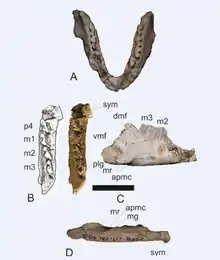Prohegetotherium
Prohegetotherium is an extinct genus of mammals from the Late Oligocene (Deseadan in the SALMA classification) of the Agua de la Piedra, Mariño & Sarmiento Formations of Argentina, the Salla Formation of Bolivia, and Fray Bentos Formation of Uruguay.[1]
| Prohegetotherium | |
|---|---|
 | |
| Prohegetotherium fossilized lower mandibles. | |
| Scientific classification | |
| Kingdom: | Animalia |
| Phylum: | Chordata |
| Class: | Mammalia |
| Order: | †Notoungulata |
| Family: | †Hegetotheriidae |
| Subfamily: | †Hegetotheriinae |
| Genus: | †Prohegetotherium Ameghino 1897 |
| Species | |
| |
Taxonomy
Prohegetotherium comprises three species, P. sculptum, P. schiaffinoi, and P. malalhuense.[1] Although Prohegetotherium shumwayi and P. crassus have long been synonymized with P. sculptum, Kramarz and Bond (2017) restricted P. sculptum to the holotype, rejecting the synonymy.[2]
References
- Prohegetotherium at Fossilworks.org
- A. G. Kramarz and M. Bond. 2017. Systematics and stratigraphical range of the hegetotheriids Hegetotheriopsis sulcatus and Prohegetotherium sculptum (Mammalia: Notoungulata). Journal of Systematic Palaeontology 15(12):1027-1036
This article is issued from Wikipedia. The text is licensed under Creative Commons - Attribution - Sharealike. Additional terms may apply for the media files.




.jpg.webp)



